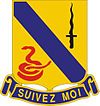14th Cavalry Regiment (United States)
| 14th Cavalry Regiment | |
|---|---|
| Active | 1901 - 1972 2000 - Present |
| Country | United States of America |
| Branch | Regular Army |
| Type | Stryker-mounted cavalry |
| Role | Reconnaissance, surveillance, and target acquisition |
| Motto(s) | Suivez Moi (Follow Me) |
| Engagements |
Philippine-American War World War II Iraq Campaign Afghanistan Campaign |
| Insignia | |
| Distinctive unit insignia |  |
| U.S. Cavalry Regiments | |
|---|---|
| Previous | Next |
| 13th Cavalry Regiment | 15th Cavalry Regiment |
The 14th Cavalry Regiment is a cavalry regiment of the United States Army. It has two squadrons that provide reconnaissance, surveillance, and target acquisition for Stryker brigade combat teams. Constituted in 1901, it has served in conflicts from the Philippine-American War to the Operation Iraqi Freedom and Operation Enduring Freedom in Afghanistan.
The 14th Cavalry was constituted 2 February 1901, by War Department General Order Number 14. The unit was organized at Fort Leavenworth, Kansas, 5 March 1901.
The 14th was stationed in the Philippines from 1903–1906 during the insurgency campaigns. Upon successful completion of that campaign in 1906, the regiment then returned home to the United States and took up garrisons in the Pacific Northwest, where it assumed peacetime duties. The regiment was re-deployed to the Philippines in 1909, although this time it was only engaged in garrison duties and training.
In 1912, the regiment was called for service in the Mexican campaign. On the night of 5-6 May 1916, a detachment of nine troopers guarding Glenn Springs, Texas came under attack by a band of about 70 Villistas in the Glenn Springs raid, and three privates, William Cohen, Stephen J. Coloe, and Lawrence K. Rogers, were killed on American soil. The unit then joined General John J. Pershing's expeditionary forces in the Mexican Punitive Expedition against Pancho Villa and his forces during the summer of 1916, chasing bandits throughout the Mexican plains. The regiment then returned to Texas, where it began the task of patrolling the border until 1918, when it was called into service in Europe. The Treaty of Versailles was signed before the regiment could cross the Atlantic and the regiment resumed its border patrol mission.
...
Wikipedia
